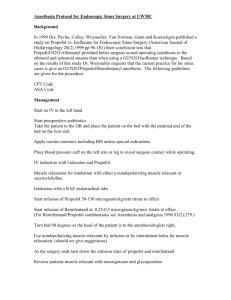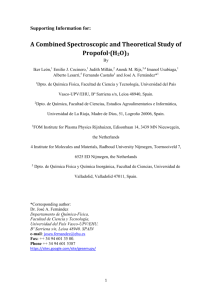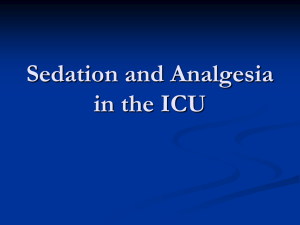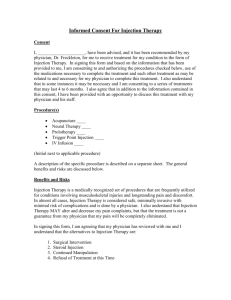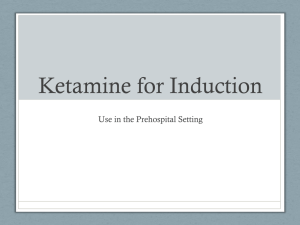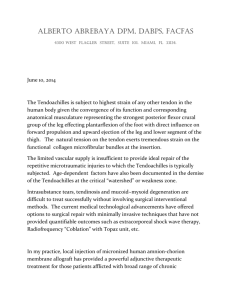UJP 14352 (Rs)b - universal journals publication
advertisement
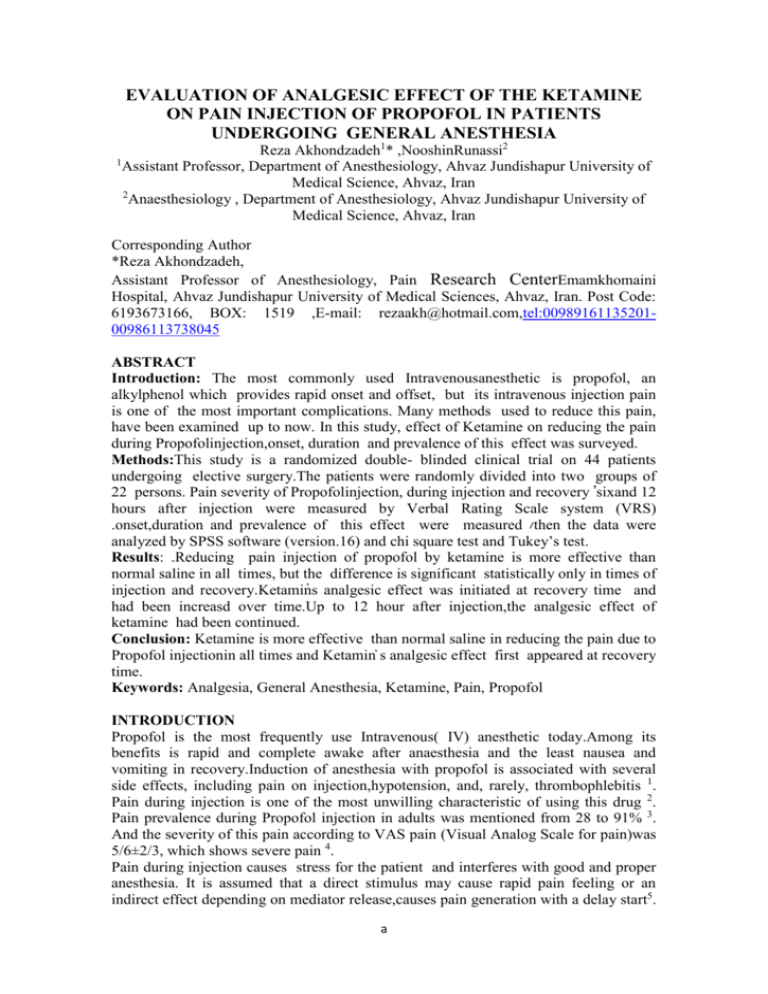
EVALUATION OF ANALGESIC EFFECT OF THE KETAMINE ON PAIN INJECTION OF PROPOFOL IN PATIENTS UNDERGOING GENERAL ANESTHESIA Reza Akhondzadeh1* ,NooshinRunassi2 1 Assistant Professor, Department of Anesthesiology, Ahvaz Jundishapur University of Medical Science, Ahvaz, Iran 2 Anaesthesiology , Department of Anesthesiology, Ahvaz Jundishapur University of Medical Science, Ahvaz, Iran Corresponding Author *Reza Akhondzadeh, Assistant Professor of Anesthesiology, Pain Research CenterEmamkhomaini Hospital, Ahvaz Jundishapur University of Medical Sciences, Ahvaz, Iran. Post Code: 6193673166, BOX: 1519 ,E-mail: rezaakh@hotmail.com,tel:0098916113520100986113738045 ABSTRACT Introduction: The most commonly used Intravenousanesthetic is propofol, an alkylphenol which provides rapid onset and offset, but its intravenous injection pain is one of the most important complications. Many methods used to reduce this pain, have been examined up to now. In this study, effect of Ketamine on reducing the pain during Propofolinjection,onset, duration and prevalence of this effect was surveyed. Methods:This study is a randomized double- blinded clinical trial on 44 patients undergoing elective surgery.The patients were randomly divided into two groups of 22 persons. Pain severity of Propofolinjection, during injection and recovery ٬sixand 12 hours after injection were measured by Verbal Rating Scale system (VRS) .onset,duration and prevalence of this effect were measured ٫then the data were analyzed by SPSS software (version.16) and chi square test and Tukey’s test. Results: .Reducing pain injection of propofol by ketamine is more effective than normal saline in all times, but the difference is significant statistically only in times of injection and recovery.Ketamin̓s analgesic effect was initiated at recovery time and had been increasd over time.Up to 12 hour after injection,the analgesic effect of ketamine had been continued. Conclusion: Ketamine is more effective than normal saline in reducing the pain due to Propofol injectionin all times and Ketamin̓ s analgesic effect first appeared at recovery time. Keywords: Analgesia, General Anesthesia, Ketamine, Pain, Propofol INTRODUCTION Propofol is the most frequently use Intravenous( IV) anesthetic today.Among its benefits is rapid and complete awake after anaesthesia and the least nausea and vomiting in recovery.Induction of anesthesia with propofol is associated with several side effects, including pain on injection,hypotension, and, rarely, thrombophlebitis 1. Pain during injection is one of the most unwilling characteristic of using this drug 2. Pain prevalence during Propofol injection in adults was mentioned from 28 to 91% 3. And the severity of this pain according to VAS pain (Visual Analog Scale for pain)was 5/6±2/3, which shows severe pain 4. Pain during injection causes stress for the patient and interferes with good and proper anesthesia. It is assumed that a direct stimulus may cause rapid pain feeling or an indirect effect depending on mediator release,causes pain generation with a delay start5. a Delayed pain (after 10 to 20 seconds) , is caused by an indirect effect on endothelium (due to Kinogenes release ) 6 . Lipid solvent causes increase an activity in Kallikrein – Kinin System in plasma, which then leads to bradykin production. This interplay causes peripheral vein dilation and permeability increases , and this is the reason to increase Propofol aqua phase contact with vascular endothelium and free efferent nerve endings between media and intima of the vascular wall ; and finally , causing pain7. Overall,Propofol is one of the drugs which causes stimulation of the skin, mucosa and the internal wall of the veins8. Until now, many methods to reduce the incidence and pain severity during Propofol injection were suggested and surveyed. Among these methods,using different emulsion usage of Propofol 9,10and different drugs like lidocaine 11 Thiopental 12, narcotic and Granisetron 13can be named. Also methods like slow injection 14, warming up andcooling down 15, and diluting of the drug 16 are used to reduce the injection pain. Ketamine is one of the non-barbiturate anaesthesic drugs and belongs to the Phencyclidine group. Good Analgesiceffect, low respiratory depression, maintenance of airway reflexes and bronchial dilation and low price are the Ketamine’s advantages compared to other anesthesia drugs.But one of the limitations of the Ketamine is the hemodynamic changes1. using available and efficient drug methods that can be beneficial effects on anaesthesia induction, led to pose the issue of surveying Ketamineeffect on the pain of thePropofol injection site and to find onset,duration and prevalence of this effect. METHODS This study is a randomized double- blinded clinical trial conducted on 44 patients undergoing elective surgerywith ASA class I and II in Ahvaz Imam Khomeini Hospital in the year 2012. The study was approved by Ahvaz Jundishapur University of Medical sciences Ethical Committee,A consent form was received from the patients prior to the study. , and all participants were signed the informed consent prior to enrollment. The patients were randomly divided into two groups of 22 persons. After the patient preparation and his transmission into the operative room, first Intravenous (IV) 20Gcannula was fix on the cubital forearmand before starting the anesthesia, the patients were being monitored:Electrokardiogram(EKG),pulse oximetry and Noninvasive boodpersure( NIBP) . Inclusion Criteria: patients candidate Electivesurgery , general anesthesia, age 1850,ASA classI,II,Body Mass Index(BMI) of 18-50 were include. Exclusion Criteria: patients under age 18 or over age 50, ASA, III, to V class, Obese Class II (BMI>35), history of Liver dysfunction, , hypersensitivity or allergy to Poropofol,AnyContandication to KetaminAdmition,Adiction to Opioide were Excluded. Groups one, two, Injected 2 cc Normal saline 0.9%, 0.1 mg/kg intravenous Ketaminerespectively.The surveyed drugs included Ketamine manufactured by RotexmedicaCompany, Germany, and Propofolmanufactured by Claris Company, India. After about 45 seconds injection of these drugs , one – fourth of the Propofol induction dose (1.5 mg/kg) was injected to each patient with the speed of 1 ml per second, and everyfive seconds, besides considering the patient’s face, the patient were asked about the pain during injection , using VRS method(Verbal Rating Scale). In VRS system, each number shows a clinical condition. Zero, one, two, and three show the no-pain condition , feeling pain or low discomfort, moderate pain, and severe b pain with change in facial expression, pulling back the hand,forearm or both, respectively. Sedation and the disability of the verbal communication was the factor to exclude the patient from the study. After asking the patient , the rest dose of Propofol was injected and immediately after loss of consciousness , 0.5 mg/kg of the Atracurium drug was injected slowly and the patient was intubated . Maintenance of anesthesia with Isoflurane 1-2% and N2O 50% -O2 50%. Finally, after endigthe surgery , the patients were reversed ( neostigmine 0.05 mg /kg , atropine 0.02 mg/kg) and they were extubated and transmitted to the recovery . Also , the patient’s pain score was asked and registered according to VRS in the recovery , 6 and 12 hours after injection time. RESULTS AND DISCUSSION In this survey, there were 20 women and 24 men . Sexual ratio of men to women in ketamin group was higher (1.4), and in the Normal saline group was the lower(0.83). In this study, the lower average age, was in the group taking Ketamine (36.86 ± 15/75 years), and the higher average age was in the group Normal salin or the control group (42/32 ± 13.67). Considering the present age differences among different therapeutic groups, statistically, there was not a significant difference about the age of the groups. According to VRS system, no patient of the Ketamine and Normal-Saline groups had score 0 (no pain) during Propofol injection.Also 19 patients out of 22 patients (86%) in the group taking Normal saline, during Propofol injection, described the pain severity high (rankthree) according to VRS system.(table 1) All patients taking Ketamine, had experienced pain with different severities during injection.Onset of analgesic effect of ketamine was initiated at recovery time in 54 % patients in ketamine group. Six hours after injection , no patient participating in the study , felt pain with moderate and high severity (ranks two and three) . Meanwhile, 18 patients of ketamine group(81%) had no pain,and the others(4 patints) experienced low pain.On the other hand,in the saline group, 12 patients(54%),had no pain,and the rest of patiens had low pain. 12 hours after injection, only one patient from the Saline group , makes acomplaint about a low pain (rank one) at the site of the Propofol injection, and another 65 patients, felt no pain at the injection site. After 12 hours,there was no significant difference among the twosurveyed drugs according to their ability to generate analgesia.(Fig 1) Ketamin̓s analgesic effect was initiated at recovery time and had been increasd over time.Up to 12 hour after injection,the analgesic effect of ketamine had been continued. The results showed that Ketamine, similar to normal saline,had no analgesic effect on pain during injection of propofol,but at the recoverytime and 6 hours after injection,ketamine is more effective to reduce painexperience than Normal Saline. The time needed for Ketamine effect, according to its easy transmission through the blood - brain barrier, is about 30 seconds to one minute which is so rapid. But, even during the injectionof the drug with the interval of 45 seconds,there was no analgesic effect of Ketamine, which this issue is considerable. In a survey conducted by anaesthesia and pain control department in South Korea in Seoul in the year 2006 by Koo et al., researchers stated that if before prescription of Propofol,100 µg/kg Ketamine is injected, the incidence and pain severity of Propofol injection will be reduced without huge hemodynamic complication 17. c Results from Safavie et al.’s research 18was similar to our study from the viewpoint of Ketamine prominence compared to Normal Saline in reducing pain during Propofol injection, and the present difference is statistically significant. In a study, SedighiNezhad , stated that in spite of the pain reduction due to Propofol intravenous injection by threestudied Pre-medication (Alfentanil, Ketamine and Magnesium sulfate), no priority can be considered for any of them ,while pain severity during injection for all these three drugs is less than Normal Saline 19. Also in another study registered in the Internet Journal of Anesthesiology in the year 2009, results showed that Pre-treatment with 0.2 mg/kg intravenous Ketamine is useful in reducing the pain of Propofol injection 20. Overall,to relieve pain caused by Propofol injection, using Pre-medication, one should pay attention to the time needed to start and for the maximum effect of the Premedication and also its dose in order to reduce the possible errors in deduction. Also the patient’s conditions and situations are among important factors in choosing a proper Pre-medication. CONCLUSION This study showed that Ketamine is more effective in reducing the pain of the Propofol injection site than normal saline.It̓s analgesic effect(score 0),first appeared at recovery time,and had been increasd over time. ACKNOWLEDGMENTS This paper is issued from thesis of NooshinRunassi,. At last, we appreciate all the persons helping us in performingparticularlyPainResearchCenterofAhvazJundishapurUniversityMedicalScie ncesforfinancialsupport. REFERENCES 1. Ronald M. Anaesthesia. 7 ed. philadelphia: Churchill-Livingstone; 2010. 2. Baker MT, Naguib M. Propofol: the challenges of formulation. Anesthesiology. 2005;103(4):860-76. 3. Cheong MA, Kim KS, Choi WJ. Ephedrine reduces the pain from propofol injection. Anesthesia & Analgesia. 2002;95(5):1293-6. 4. Haugen RD, Vaghadia H, Waters T, Merrick PM. Thiopentone pretreatment for propofol injection pain in ambulatory patients. Canadian journal of anaesthesia. 2008;42(12):1108-12. 5. Dubey PK, Prasad SS. Pain on injection of propofol: the effect of granisetron pretreatment. The Clinical journal of pain. 2003;19(2):121-4. 6. Soltész S, Silomon M, Gräf G, Mencke T, Boulaadass S, Molter GP. Effect of a 0.5% dilution of propofol on pain on injection during induction of anesthesia in children.Anesthesiology. 2007;106(1):80-4. 7. Dubey PK, Kumar A. Pain on injection of lipid-free propofol and propofol emulsion containing medium-chain triglyceride: a comparative study. Anesthesia & Analgesia. 2005;101(4):1060-2. 8. Suzuki H, Miyazaki H, Andoh T, Yamada Y. Propofol formulated with long‐ /medium‐chain triglycerides reduces the pain of injection by target controlled infusion. Actaanaesthesiologicascandinavica. 2006;50(5):568-71. 9. Pollard RC, Makky S, McFadzean J, Ainsworth L, Goobie SM, Montgomery CJ. An admixture of 3 mg· kg− 1 of propofol and 3 mg· kg− 1 of thiopentone reduces pain on injection in pediatric anesthesia. Canadian Journal of Anesthesia. 2002;49(10):1064-9. d 10. McCluskey A, Currer B, Sayeed I. The efficacy of 5% lidocaine-prilocaine (EMLA) cream on pain during intravenous injection of propofol.Anesthesia & Analgesia. 2008;97(3):713-4. 11. Kim K-M, Choi B-M, Park S-W, Lee S-H, Christensen LV, Zhou J, et al. Pharmacokinetics and pharmacodynamics of propofolmicroemulsion and lipid emulsion after an intravenous bolus and variable rate infusion. Anesthesiology. 2007;106(5):924-34. 12. Ambesh SP, Dubey PK, Sinha PK. Ondansetron pretreatment to alleviate pain on propofol injection: a randomized, controlled, double-blinded study. Anesthesia & Analgesia. 2001;89(1):197-9. 13. Rau J, Roizen MF, Doenicke AW, O’Connor MF, Strohschneider U. Propofol in an emulsion of long-and medium-chain triglycerides: the effect on pain. Anesthesia & Analgesia. 2001;93(2):382-4. 14. Lee E-H, Lee S-H, Park D-Y, Ki K-H, Lee E-K, Lee D-H, et al. Physicochemical properties, pharmacokinetics, and pharmacodynamics of a reformulated microemulsionpropofol in rats. Anesthesiology. 2008;109(3):436-47. 15. Apiliogullari S, Keles B, Apiliogullari B, Balasar M, Yilmaz H, Duman A. Comparison of diphenhydramine and lidocaine for prevention of pain after injection of propofol: a double-blind, placebo-controlled, randomized study. European journal of anaesthesiology. 2007;24(3):235-8. 16. Agarwal A, Ansari MF, Gupta D, Pandey R, Raza M, Singh PK, et al. Pretreatment with thiopental for prevention of pain associated with propofol injection. Anesthesia & Analgesia. 2004;98(3):683-6. 17. Koo S-W, Cho S-J, Kim Y-K, Ham K-D, Hwang J-H. Small-dose ketamine reduces the pain of propofol injection. Anesthesia & Analgesia. 2006;103(6):1444-7. 18. Reza SM, Azim H. Comparative surgery of intravenous Pre-medication Sulfate Magnesium , Ketamine, and Lidocaine on reducing pain while injecting Propofol. Mazandaran University of Medical Sciences Journal. 2007;17(60):30-8. 19. Abbas S, Mohammad H. Comparison the effect of Alfentanil ,Magnesium Sulfate and Ketamine on reducing pain during intravenous Propofol injection. Scientific Season Journal of Anaesthesia and pain. 2011;2(5):31-6. 20. Kad N, Malik P, Dureja J, Thakur A. Ketamine pretreatment to alleviate the pain of propofol injection: A randomized, double blind study. Internet Journal of Anesthesiology. 2009;20(2). Table1: Prevalence of patients in both groups via VRS Summary 0 7 12 25 44 N/S gr. 0 0 3 19 22 e Ketamine gr VRS rank 0 7 9 6 22 0 1 2 3 Summary f
